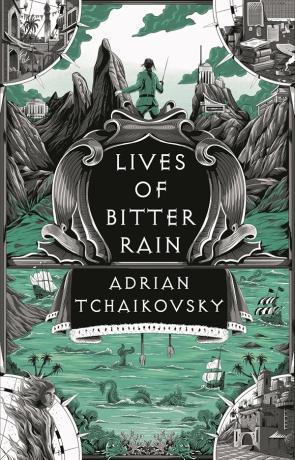The Evolution of the book

As books have now reached the 21st century with the creation of the increasingly popular e-book format, we thought it would be a good idea to take a look back at the long and involved history of the humble book.
From the clay tablets to the e-book format, the book has enjoyed a remarkable evolution, presented here is a snapshot of that history:
3500 BC - Symbols onto Tablets
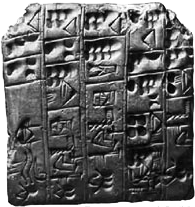
Current understanding suggests that the very first attempts to transcribe symbols onto moveable materials were an ancient group of people known as Sumarians who lived in southern Mesopotamia around 3500 BC. Mesopotamia is an ancient name for the area in the middle east that stretches from the Zagros Mountains in the northeast to the spurs of the Anti-Taurus Mountains in the north west and the Persian Gulf in the south east to the Arabian Plateau in the south west.
The Sumarians devised a "cuneiform" alphabet (a system that consists of logophonetic, consonantal alphabetic and syllabic signs), the symbols of which were etched into clay tablets with a triangle shaped stylus called a "Calamus" and then allowed to dry or fired in a kiln to make them last as long as possible. The Sumarians are believed to be the first people to ever use the Cuneform script, which itself is the earliest known written system in the world.
2400 BC - Papyrus Scrolls
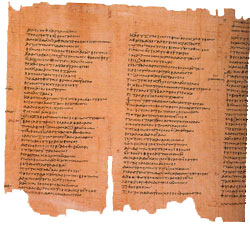
The earliest surviving Papyrus scrolls that contain written words date back to around 2400 BC, originating in Egypt (The Fifth Dynasty of King Neferirkare Kakai), although it has suggested by historians that papyrus could have been used as early as the First Dynasty (3100 BC).
Papyrus is a very thick paper like material that is made from the "pith" (centre of the stem) of the papyrus plant, a reed like swamp plant that used to be found in abundance along the Nile river. This "pith" was cut into thin strips, pressed together and then glued and dried to form a thin flat surface that could be written on. Again a calamus cut from the stem of a reed and then sharpened was often used to scribe but bird feathers were also used.
Egyptians used this material for hundreds of years before the Greeks and Romans eventually adopted the technique. These scrolls were rolled up and often contained within wooden tubes to protect them and books were produced by glueing together a number of scrolls up to a length of 10 metres or in some cases even longer (The history of the Egyptian King Ramses III was over 40 metres long).
The Books were always rolled out horizontally and the text occupied on side, split into columns. This method of writing was used extensively until the 8th century AD.
600 BC - Standardised writing system developed
Around this time a general consensus of mediterranean cultures slowly emerged to form a more developed writing system. This favoured the left to right system that is now the standard in western cultures, although there is still a number of written scripts that use the right to left script, including Arabic and Hebrew.
Before this was decided many cultures wrote left to right, right to left, up to down and even down to up.
500 - 200 BC - Parchment
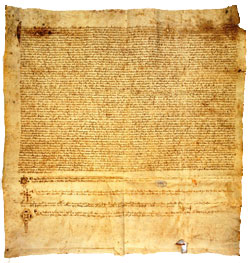
Parchment, a thin material that is made from calfskin, sheepskin or even goatskin was first developed as a substitute to Papyrus. Herodotus, the Greek historian who lived in the 5th century BC (regarded as the "Father of History" in Western culture) described the use of skins to write on as common in his time. According to the Roman Varro (a scholar and writer who lived 116BC - 27BC) parchment was invented under the patronage of Eumenes of Pergamum (an ancient Greek city in modern-day Turkey) due to shortages of Papyrus.
Parchment itself derives it's name from the city of Pergamon (the same Greek city as Pergamum) and it is known to have been perfected here. After a great library was setup in Pergamon (that rivalled the Library of Alexandria) prices began rising for the price of papyrus (partly due to the increasing scarcity of the papyrus reeds as it was overfarmed) leading to the adoption of parchment as the main writing material.
Parchment is distinct from leather in that it is limed (soaked in an Alkali solution which removed the hairs on the skin) but not tanned. As such parchment reacts with changes in humidity (being partly hydroscopic) and is not waterproof. The finer quality parchments are known as vellum and even in the modern age parchment has been called the "finest writing material ever devised" with even the most modern papers not reaching the quality of the finest vellum.
200 BC - Wax Tablets developed
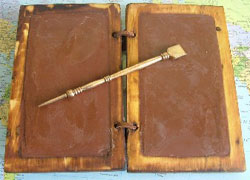
It was around this time that the wax tablets were developed by the Romans and Greeks. The tablets were essentially blocks of wood with were coated in wax allowing them to be written upon using a stylus, and later erased for re-use.
These tablets were sometimes joined together at one end with cords (like an early form of ring binder) to form a "codex" (original latin meaning "wood" but later known as a collection of bound pages), as such this is the earliest known form of a bound book. The "codex" became very popular around europe, replacing the scroll.
105 AD - The Paper Revolution
It is generally accepted that a chinese eunuch (attached to the imperial court) named Cai Lun invented papermaking for the intention of writing and used a combination of mulberries, bark, hemp, old rags and even used fish nets for the creation of the paper pulp, around 105 AD. Recent archaeological discoveries have been reported from near Dunhuang of paper with writing on it dating from 8 BC, while paper had been used in China for wrapping and padding since 200 BC.
The process of papermaking regardless of scale involves making a mixture of fibers in water to form a suspension and then allowing this suspension to drain through a screen so that a mat of fibers remains. This is then pressed and dried to make paper. After the paper is dry it is often run between heavy rollers to produce a harder writing surface (this process is known as calendering).
Paper can be "sized" to reduce the absorption of water and there are 3 categories - unsized (water-leaf) which is very absorbent and used for blotting and paper towels, weak sized (slack sized) which is still somewhat absorbent and used for newspapers and strong sized (hard sized) which offers good water resistance.
When paper was originally developed it was a fairly standard size and each peice of paper is known as a "leaf". When a leaf is printed on without being folded it is refered to as a "folio" (which also means leaf) this size is roughly that of a small newspaper sheet (although folio can be other sizes). If this original folio is folded once to produce two leaves (or 4 pages) then the size of these leaves is refered to as a Quarto. If a Quarto is folded once to produce 4 leaves (or 8 pages) then this is known as a Octavo and is about the size of an average modern novel (there are also Sixteen-mo and even thirty-two-mo but this is less common).
400 - 600 AD - Illustrations added
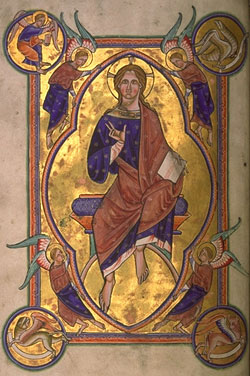
It was around this time that the first illustrated handwritten manuscripts (also known as illuminated manuscripts) appeared. These early manuscripts were still written on Parchment (which had replaced Papyrus) rather than the more "modern" paper due to the quality of Parchment over paper.
These handwritten books were decorated in silver or even gold with striking colours and very detailed designs.The earliest known examples of illustrated manuscripts originate from Italy and the eastern Roman Empire.
In Europe this became a very highly developed art form (as well as some Muslim countries) and this method of transcribing books prevailed until the invention of the moveable type.
The significance of these works lie not just in the artwork itself but also in the maintainence of the non illustrated works. Had this not been done (mainly by the monastic scribes of the Late Antiquity (a time that stretches from the 3rd to 7th centuries AD) then it is likely the entire collection of literature of Greece and Rome would have perished.
868 AD - The First Printed Book
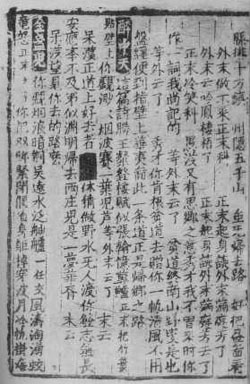
The very first book is printed on paper in China, using a block of wood that had characters carved in reverse relief. Ink was then placed on the block of wood to create a print on paper.
This technique is known as "block printing" or more accurately in this case "woodblock printing" and was originally used as early as 220 AD as a means of printing on cloth.
A block of wood is carefully prepared with a knife, chisel or sandpaper along the grain of the wood as a "relief matrix", so that the raised areas are the black type. The content has to be created in reverse so that when printed it forms the mirror image. This process of carving the wood is known as Xylography.
Block printing could even be done in colour, by using multiple blocks (one block for each colour), although overprinting two colours can produce further colours on the print. Multiple colours can be printed by keying the paper to a frame around the woodblocks.
1041 AD - 1230 AD - The First Moveable Type
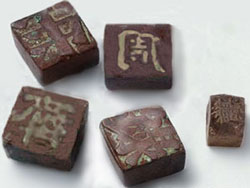
Moveable type is the system of printing and typography that uses movable components to reproduce the elements of a document (usually individual letters or punctuation).
A Chinese man called Bi Sheng came up with the very first moveable type, with each letter created from wooden pieces (tablets) and then placed onto a wooden board. This wooden method was not without it's problems however, the most serious of these being the ink soaking into the wood and creating an uneven surface. As a result of these issues wooden moveable type was quickly abandoned and replaced with ceramic tablets, which were made from baked clay.
Due to the complexities of the chinese written language (there had to be thousands of ceramic tablets) moveable type didn't really catch on for quite some time in the east.
Around 1230 AD the very first metal moveable type was created, this time in Korea during the Goryeo Dynasty. This breakthrough led eventually the the very first movable metal print book in 1377 AD called the "Jikji".
1250 AD - Block Printing in Egypt
Block printing (called Tarsh in Arabic) arrived in Egypt around this time, although it is unclear if this was developed separately or influenced by the block printing already in use in Asia (although Arabic chronicles confirm that paper making in Egypt was developed from Central Asia). This block printing method appears to be almost exclusively used by the Muslim community.
Most surviving extant prints suggest that block printing was mainly restricted to religious texts such as amulets (long thin strips of paper bearing quotes from the Quran, listing the names of God and other texts designed to ward off evil). These "amulets" were rolled into metal tubes and worn around the neck on a chain.
It is unknown why block printing never developed within Egypt, or the Muslim community but it is thought that this may be due to the fact that Tarsh was used by Itinerant tinners, rogue scribes (such as Abu Dulaf al-Khazraji who frenquented the courts of Iranian Buyid princes and has written of the Tarsh process) and other confidence men who could take advantage of the piety of the gullible masses. This would explain it's insulation from the rest of society and why the technology was never expanded upon.
1439 - 1450 AD - Moveable Type in Europe
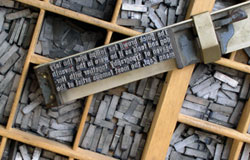
The very first moveable type is developed in Europe by a German goldsmith by the name of Johannes Gutenberg (full name Johannes Gensfleisch zur Laden zum Gutenberg), who is known to have developed this technology independantly of the moveable type system in use in Asia.
Already familiar with the technique of cutting punches for coins and moulds, Johannes developed a metal moveable type system of casting letters from matrices using a device called a hand mould (a very simple two part mould which contains the hand-made moveable type). The matrix itself was produced from a lead alloy (known as type metal) which was discovered by Johannes himself. This alloy allowed for more durable and uniform lettering which eventually gave rise to typography and fonts.
The hand mould was the very first practical method of producing cheap copies of letterpunches in the vast quantities required for printing of the average book. This made moveable type a viable business and this is seen as truly monumental invention that has revolutionised the writing and printing of information and led directly to the printing press.
This is widely regarded as the most important event of the modern period and played a key role in the development of the Renaissance, Reformation and the Scientific Revolution while at the same time spreading a means of learning to the masses and forming the basis for the modern knowledge-based economy we see today. Practically all moveable type printing derives from Gutenberg's metal alloy moveable type, often regarded as the most important invention of the second millennium.
1455 AD - The Guttenburg Bible
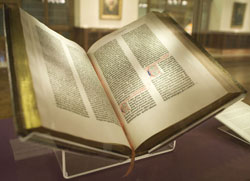
The invention of moveable type in Europe by Johannes Gutenberg led directly to his major work, the creation of the Gutenberg Bible (also known as the 42-line Bible, the Mazarin Bible or the B42). This was the very first major book to be printed using Gutenberg's new moveable type printing press and marked the start of the Gutenberg Revolution and the dawn of the printed book.
The Gutenberg Bible has an iconic status in the western world and has been widely hailed for it's high artistic and aesthetic qualities. There are thought to be 21 complete copies still in existence and are considered to be the most expensive books if they were ever to go on sale.
Gutenberg made 3 very significant changes during the print process for the Bible, the first change was "Rubication" (a process that involved adding additional text in red for headings, a starting character or annotations) of the pages by being passed twice through the press, with the second pass being made in red.
This process was soon abandoned with spaces being left for the Rubication to be added by hand. Some time after this the number of lines were increased from 40 to 42, most likely to save on paper. As a result pages 1-9 and pages 256 to 265 have 40 lines (being the first ones printed), page 10 has 41 lines and the remaining pages all have 42 lines.
The third change was to increase the print run which meant that those pages that had already been printed had to be reset. All new sheets used the new default of 42 lines. As a result there are two disctinct settings in the folios 1-32 and 129-158 of volume I and folios 1-16 and 162 of volume II.
The Bible is printed in what is now called the "blackletter" type styles of Gothic Bookhand (Textualis) and Schwabacher and followed the technique of justification. These books left the workshop unillustrated, unbound and mostly un-rubicated. A guide was produced for the Rubicators to add text and a generous margin was left for illustrators although some copies were left unillustrated.
It is believed that in total 180 copies of the Gutenberg Bible were created, 135 on paper and a further 45 on vellum. Of these it is known that 21 exist in complete condition while there are a further 26 or 27 copies that are incomplete. Of these 12 are on velum, but only 4 complete (one in France, one in Germany, one in the British Library and the last in the Library of Congress, USA).
After Gutenberg produced his Bible he fought and lost a lawsuit against his investor Johann Fust, who put Peter Schoffer (Gutenberg Employee) in charge of the print shop. Gutenberg himself started a new print company but the monopoly over the technology was lost and thus began the endemic spread of print presses throughout Germany and the rest of the world.
1490 AD - 1500 AD -The Printing Revolution
Gutenberg's invention of mechanical moveable type (printing press) led to a mass revolution of printing activities and by the end of the 15th century printing had spread to no less than 236 countries in Europe, with more than 20 million books produced. From this time onwards it is generally assumed that the printed book was in universal use throughout Europe.
This rapid expansion and sharp fall in production costs took everyone by surprise, created the very first "bestsellers", the very first Newspaper and a whole new branch of media with the publishing press.
This print revolution was not simply limited to Europe, the nearly simultaneous discovery of sea routes to the West by Christopher Columbus in 1492 and routes to the East in 1498 by Vasco da Gama allowed trade links to be established and meant Gutenberg's press spread to the rest of the world.
1501 AD - The Precurser to the Modern Paperback
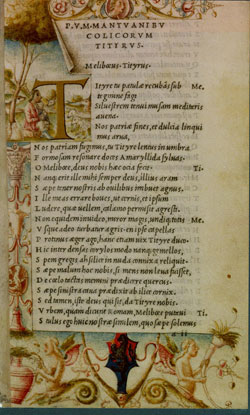
As the printing revolution gathered pace, many improvements were made to both the printing method, and the typeface. Aldus Manutius (Aldo Manuzio il Vecchio in italian) was an Italian humanist who founded the Aldine press in Venice. Aldus has the distinction of inventing italic type, establishing the modern use of the semicolon and most importantly, introducing inexpensive small format books (octavos) which were bound in vellum and were read much like the modern paperback.
It was Aldus's desire to secure Greece's rich literature from any further loss that encouraged him to adopt the small book format.He invented the pocket book editions of the classics in Greek and Latin so that all could own and read these books but also gentlemen of leisure could easily transport in a pocket or a satchel. To this end he introduced the italic type, which was not used for emphasis as it is today but for his pocket books due to the narrow and compact letter forms. The very first book to be printed in this new pocket book format was Virgil's "Opera" (P. Vergili Maronis Opera) in 1501 AD.
1639 AD - 1640 AD - America's First Book
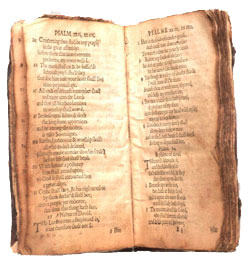
Puritans arrive in the new land of opportunity and they bring with them North America's very first printing press. This press was specifically transported to print America's very first book, "the Bay Psalm" which was published at Cambridge, Massachusetts in 1640 AD. The Bay Psalm is essentially a "psalter", a volume containing the book of Psalms (150 sacred poems from the Hebrew Bible, which are sung), translated into English. There are Eleven copies of this first edition known to still exist and David Baldacci's 2006 novel "The Collectors" considers the discovery of a twelfth complete copy.
At the time of printing there were 13 British colonies and it is a mark of their desire to consider themselves an "advanced civilisation" that this press arrived and the book printed just 20 years after the Mayflower arrived at Plymouth Rock and with it the very first British Colonists.
1744 AD - The Discovery of Chlorine
While the most common compound of Chlorine, sodium chloride (salt) has been used since at least 3000 BC (Brine even as early as 6000 BC), the discovery of the Chlorine element wasn't discovered until 1744 AD by the Swedish chemist Carl Wilhelm Scheele. Scheele observed the gas produced by the reaction of Hydrochloric Acid (known as Muriatic acid at the time) and Manganese Dioxide. Although Scheele is credited with the discovery, it was the British chemist (also an Inventor) Sir Humphry Davy who actually gave the element it's current name.
So why is this element appearing in the history of the book? Chlorine is used in the bleaching of paper and without this discovery the modern paper would not have that nice clean white look.
1832 AD - Book sleeves appear
1832 AD marks the very first books to be covered in printed detachable paper jackets, with the very first book covered this was is believed to be "The Keepsake", an "annual" (later known just as "the Annual") of stories written primarily by Walter Scott and produced by Charles Heath.
This book jacket design remained relatively unchanged for the following 60 years until the first 2 decades of the twentieth century brought new designs and ideas.
1832 AD to 1860 AD - Birth of the "cheap" Novel
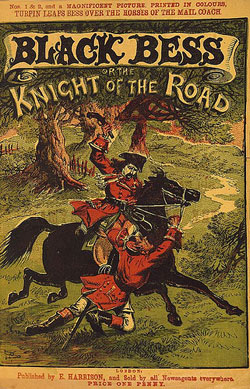
With the continued spread of the written word, along with a growth in education and the continued reduction in print costs, the first mass-market paperbacks were born. In Britain there were two distinct markets these mass publications were aimed at, the juvenile market with the "story papers" and the working class adult which were known as a "penny dreadful", "penny number" or a "penny blood" - due to the fact that they each cost a "penny". Eventually these novels were exclusively aimed at the working class youth market and the term story paper became interchangeable with penny dreadful.
These stories were printed on cheap "pulp" paper and featured reprints or rewrites of stories, largely in the Gothic thriller or Crime genre including the tales of Sweeney Todd and Varney the Vampire. One of the most popular of these series was "Black Bess or the Knight of the Road" which ran for an impressive 254 episodes and featured fictional events of the real life Highwayman Dick Turpin.
Even as far back as the late 1800's America began to influence the British culture with many of their version of pulp stories being published in England. A good number of these proved remarkably popular with largely wild west tales such as "Deadwood Dick" and "Buffalo Bill" delighting the penny dreadful audience, thus began for many the love affair with the largely fictional wild west and "cowboys and indians" tales.
Those working class boys who could not afford a penny a week often teamed up with friends to form reading clubs and share the cost. Some of the more entrepreneurial of boys would even rent their copies out to others.
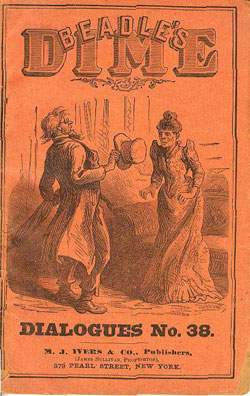
In America these pulp novels were known as "Dime Novels" and are thought to have begun with Beadle & Adams "Beadle’s Dime" Novel series in 1860 AD, the first book of which was "Maleaska, the Indian Wife of the White Hunter" (written by Ann S. Stephens). The Beadles Dime series ran for 321 issues and established nearly all the conventions of the genre. Much of the material for dime novels came from the weekly story papers which were newspaper like publications varying from tabloid to full broadsheet in size. By the 1880's re-occuring characters began to appear, like Frank Reade (a detective and first ever character to be called "sleuth") which began the end of the trend for the wild west stories that had so far held sway and made way for the hugely popular detective novel.
In the modern age the term "dime novel" is generally used to describe a sensationalized yet superficial piece of written work. Without the penny dreadfuls and the dime novels we would likely have never seen the mass market paperback that has become so widely used in the 20th and 21st Century.
1920 AD - 1938 AD - The fall and rise of the Paperback
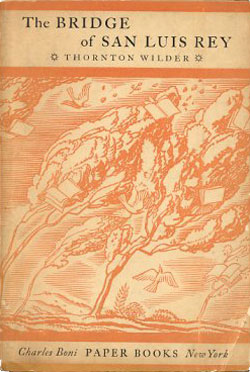
By the start of the 20th Century the hardback book was a common site and those hardback publishers considered paperback books to contain lower quality or trashy content and that these pulp novels would not appeal to their market audience. In the early 1920's this was even proved in the US market after a test was run by the release of Gertrude Atherton's "Sisters-in-Law" novel which was simultaneously released in both hardback (for $2) and paperback (for $1.5). The result was that the hardback outsold the paperback by a ratio of 54 to 1, and of those paperbacks sold, the majority were bought by 1 dealer hoping to get rich (which he didn't). Other similar experiments had the same results.
There was however one publisher who did have a great deal of success with the paperback format, even though he was not exactly "mainstream" in publishing and advertising. The publisher was an American eccentric called Emanuel Haldemann-Julius who took out newspaper adverts for his "University in Print" series of mini-mini books which were wrapped in paper and cost only three cents each. A standard blue cover was used, the series named "the little blue books" and the orders went through the roof. In the first year alone (1921) he sold over 31 Million little blue books!. By 1925 Publisher's Weekly proclaimed him "the greatest publishing house in history" but due to his atheism and communist views along with very poor publishing standards and his unethical advertising methods he never became mainstream.
Meanwhile the Boni Brothers who had founded the Modern Library (which eventually became Random House, the largest publishers in the world) had been watching these publishers and learning from their mistakes. They realised that all these paperback revolutions had their greatest success from their mail orders, not those books sold in stores. As a result of this research they launched "Charles Boni Paper Books" which was a mail order book club and for the yearly subscription charge of $5 their members would receive periodic mailings of high quality literature in paper back form. To add appeal to the mainstream market, and give an air of prestige to the books each one was illustrated by a renowned artist such as Noman Rockwell and Rockwell Kent. Unfortunately the year the Boni Brothers started their venture (1929) was the same year of the massive wall street crash and their business was doomed. Their influence however would be widespread with the eventual proliferation of the book club and the further popularisation of the paperback form.
1933 AD Nazis begin burning books
10th May 1933 marked the beginning of the burning of books by the Nazi regime in an effort to control the German history, culture, belief and ideology to fit with that of the Nazi parties goals. The Nazi Minister for "Popular Enlightenment and Propaganda", Joseph Goebbels led the effort to purge any unwanted information including organizations of Jewish and other officials who the Nazi's suspected to be politically suspect or who worked outside of the Nazi ideals. Goebbels has the support of the National Socialist German Students’ Association and many students made up the vanguard of the early Nazi movement.
On the 10th of May German students marked the beginnings of state censorship with the burning of over 25,000 volumes of "un-German" books and throughout the country right-wing students marched in torchlight parades "against the un-German spirit." In a real sense of irony, among those works burned that night were the writings of the nineteenth-century German Jewish poet Heinrich Heine, who wrote in his 1820-1821 play Almansor the famous admonition, "Dort, wo man Bücher verbrennt, verbrennt man am Ende auch Menschen": "Where they burn books, they will also ultimately burn people."
1935 AD - 1945 AD - The March of the Penguin
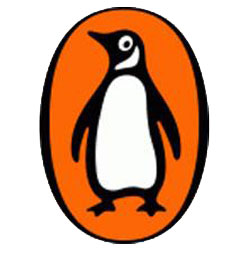
1935 saw the very first Penguin paperbacks published, founded by Sir Allen Lane which began life as an imprint of the publishers Bodley Head. The general perception of paperback books however was still on of lurid and poor quality content, and the low price that they sold for (hindering profit margins) did not appeal to Bodley Head. This enabled Lane to purchase the publication rights for a number of works for much less than he would have otherwise.
Rather than choosing the "low brow" works, Lane purchased the rights to 10 "high class" titles which he intended to print in the paperback format. Given the perception of the market this was a massive gamble, and even riskier he ordered huge print runs of 20 000 copies at a time to keep costs down. These risks paid off though, the high street chain Woolworths purchased 63000 penguin books and within 2 days they had sold out, this allowed Lane to establish Penguin as a seperate business by 1936.
By March of the same year, only ten months after it was founded, Penguin had printed over 1 million books. Part of Lane's success lie in his design and branding of the books in order to appeal to the mainstream market. Rather than bright, garish or gaudy designs, the Penguin books were designed with 3 simple stripes, with the upper and lower stripe colour denoting which series the book belonged to and the middle stripe kept white. In this center stripe was printed the book title and author name while the upper stripe held the Penguin logo.
1937 brought Penguin's first imprint, Pelican books which were designed to educate the reading public rather than entertain. The second world war did not effect Penguin as much as other publishers and by 1940 another imprint was launched, this time aimed at the children's market. Continuing with the bird theme, this new imprint was named Puffin books. For the first year Puffin books printed only non-fiction titles but in 1941 they started publishing fiction, the first novel of which was Barbara Euphan Todd's "Worzel Gummidge".
In 1945 Penguin created what could be considered it's most important, and successful imprint with Penguin Classics which began with a translation of the seminal work - Homer's Odyssey. This success and steady stream of innovation coupled with Lanes ability to judge the market trends was influential in ensuring the success of the humble paperback and it wasn't long before Penguin gained competition.
1971 - AD - The first microprocessor invented
While computers had been around in some form before 1971, it was this date that the very first commercial microprocessor became available in the Intel 4004 although there were actually 3 companies to produce a microprocessor all about the same time with Texas Instruments TMS 1000 and Garrett AiResearch's CADC. These breakthroughs in computer design would ultimately lead to the technological revolution we are currently a part of and enable the digitisation of the book.
1985 AD - First books on CD
In 1985 one of the USA's largest publishers of encyclopedias published a text only version of the Academic American Encyclopedia, which they re-named "The New Grolier Electronic Encyclopedia". This has the distinction of being the very first book to be published on a CD. Since this time a number of books have been published on this media but by far the most popular use for this format has been the audio book (which were actually published on cassette tape before CD's were available).
1989 AD - Internet and HTML arrive for public use
While the term "internet" was first coined way back in 1974 after publication of the first specification for the TCP protocol, it wasn't until 1991 that the internet become commercially available. The very first commercial ISP (offering dial-up access) was first formed in 1989, in the USA. 1989 also marks the creation of the World Wide Web (WWW) by Tim Berners-Lee and team at CERN in an effort to make it easier to publish information on the Internet
1995 AD - Books sold Online

The very first online bookseller, Amazon is launched by Jeff Bezos in 1995 offering a wide choice of books to buy online. Bezos' idea was to create an online bookstore that was not limited to the volume offered by traditional book shops or even mail order books. The very first book sold online by Amazon: "Fluid Concepts and Creative Analogies: Computer Models of the Fundamental Mechanisms of Thought" which goes someway to showing what the online shopping demographic was like back in 1995.
Amazon proved an almost overnight success which was partly due to it's unusual business plan that included not planning to make profit for the first 4 to 5 years. While other internet companies grew blindingly fast, Amazon's slow but steady growth caused some concern for it's stock-holders however when the dot-com bubble burst, this business plan meant that it survived where many others crashed and burned. Originally selling only books, Amazon expanded into Music and film and can now be seen to offer a massive range of products and services.
Incidentally, if you look at Amazon's logo on the left you will notice an arrow pointing from the a to the z of the logo and this represents Amazon's desire to offer "everything from A to Z".
Amazon is widely acknowledged as leading a revolution in online shopping and e-commerce itself. A survey carried out in 2009 and published by Verdict Research showed that Amazon is the UK's favorite music and Video retailer while in the US Amazon is second only to Walmart amongst retailers in market value.
1996 AD - Google is Born
The Internet Search giant Google began life as a research project by co-founders Larry Page and Sergey Brin who were students at the Stanford University in California. Page and Brin were working on a research project that was supported by the Digital Library Technology Project. Thier ultimate goal was to make digital Libraries work with a vision of the future in which vast collections of books are available digitally and people would use some form of "web crawler" to index the book's content and analyze the connections between them, allowing a determination of any given books relevance and use by tracking the number and quality of citations from other books.
The result of their efforts was BackRub, a modern twist on the traditional citation analysis and the fore-runner to Google's PageRank algorithm.
In 2002 Google officially launched it's "book" project, and they began to ask experts and gain research into just how long it would take to scan the world's books. The answer was unclear but it didn't stop Page and Brin from developing their idea and before long books were being digitized at a tremendous rate.
2000 AD - 2006 AD The start of the e-books Market
The very first e-books were produced way back in the early 1970's by the Gutenberg Project (a volunteer led effort to digitize and archive cultural works, mostly Public Domain books) however it wasn't until the turn of the 21st century that this format become generally available and accepted as a publishing format. This was led by a novella by Stephen King called "Riding the Bullet" which became the very first mass-market electonic book, published in 2000 AD. Within the first 24 hours of release, the novella sold over 400 000 electronic copies which broke the publishers servers and led to fans having to wait for hours before they could download a copy.
Despite this success, the e-format was not seen as commercially viable by most publishers at first, not helped by a lack of any standards and portable reader technology.
2007 AD - The Kindle becomes the first e-book reader
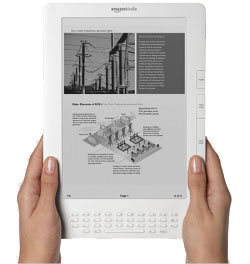
Amazon release the first ever dedicated e-book reader on November 19, 2007 which they name the Kindle. Available only in the US, the Kindle sold out within 5 1/2 hours and remained out of stock until late April 2008. The first generation of Kindle featured a 6" screen with a 4 level greyscale display and 250MB of storage (enough space for about 200 non-illustrated titles) and had a slot for an SD memory card.
On the 23rd February 2009 the second generation of Kindle was released, again only in the US. The Kindle 2 featured the same size screen but in 16 grayscale shades, an improved battery, faster page refreshing, a text to speech and read aloud facility and 2GB of memory (allowing an estimated 1500 non-illustrated e-books to be stored) however the SD Memory slot was removed so no memory expansion was available.
On the 19th October 2009 a version of the Kindle 2 was made available in over 100 countries, including the UK. The International version of the Kindle 2 is almost the same as it's US counterpart with the only real difference being a different mobile network standard based on AT&T in the US, 3G, EDGE and GPRS in the rest of the world.
Since the Kindle launched there have been a number of e-book readers released from a variety of companies including Sony with their "PRS-500" and PRS-505 readers, the latter of which was the only e-reader available in the UK for some time. Other companies include Barnes & Noble with their "nook", Iriver with their "story" and IRex Technologies with the "Iliad" to name jus a few. This huge support for the e-book format, which has been widely supported by most publishers has meant that the e-book now sells in large volumes, it has even been predicted by Sony that e-books will outsell the paper format by 2015.
One distinct advantage of this new format is that it allows those new, unheard of and self publishing authors to distribute their works with very little cost. At present though the only thing holding back the e-book is that some see the format as a way to increase profit margins rather than lower the cost of ownership and as such it is actually possible to purchase some novels in paper formats for less than the electronic formats. This is of course also held up with the huge second hand book trade which enables a reader to aquire novels at a very low cost.
2008 AD - Speeding up the scanning of Books
Devices suchg as BookSnap - a digital book scanning system that enables very fast, high quality digital scanning of books - is helping to digitise the world that much quicker. This whole digitisation movement is still headed by the goliath Google but many publishers are now beginning to offer older, out out of print works in digital format for the first time. Gollancz is leading the way in this regard with SF Gateway - a place that offers thousands of SF Classics in digital formats.
2014 AD and Beyond

It's difficult to predict just what direction the book will ultimately take, there is no doubt that Tablets, Smart-phones and E-readers have become very popular. A side-effect of this has been a big surge in Audible books with sites such as Audible allowing a digital download onto tablet, smartphone and most e-readers.
We have still yet to see the promised ultra thin, flexible e-reader that can be rolled up and stuck in a pocket, but I imagine that this is not too far away.
The ability to purchase, download and read a book almost instantly is a difficult one to resist. In addition the capability to literally carry your library of 1000's of books in your hand or even pocket is quite incredible. As the distribution of the first printing presses led to a reading revolution for the masses, the distribution of the e-book has the potential to help educate those in third world countries and provide access for a huge range of literature.
If we look far enough into the future maybe we will see William Gibsons ideas come to life where vast libraries of information are stored directly in our brains and we can access the literature of the ages just by thought.
I personally believe however that the whole tactile and sensory experience that the paper format offers is one that is with us to stay and it's really up to us as the consumer as to just what ratio of electronic to traditional format will ultimately work.
So far this is indeed proving true, many people are still buying paper books and recently there has been a new lease of life for independent bookshops. Like video failed to kill the radio star, so it appears that solid, paper books are here to stay.
